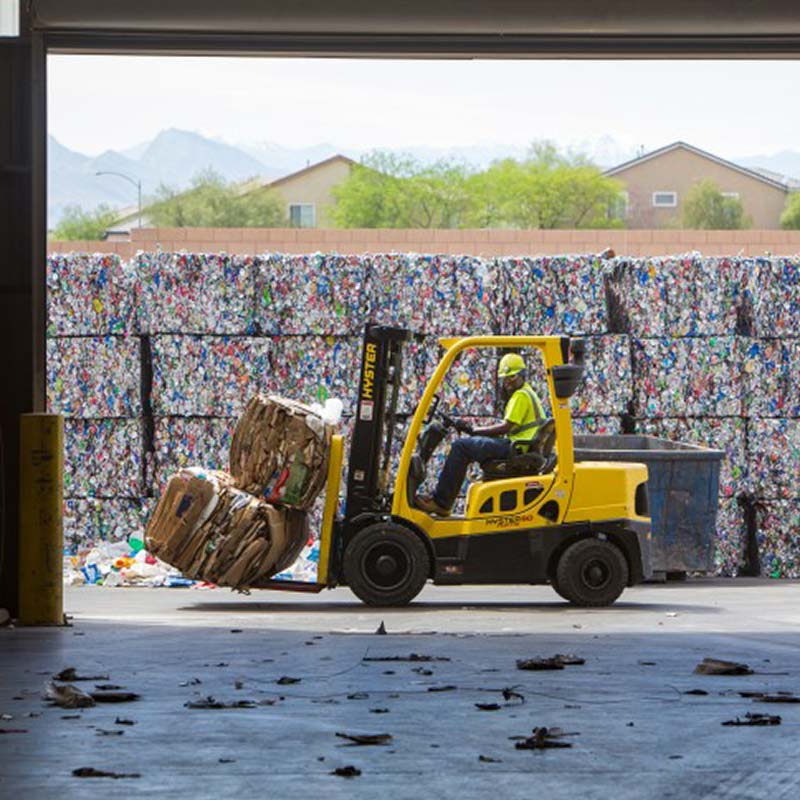When it comes to safety in the recycling industry, we have rightly put high emphasis on lock-out/tag-out (LOTO) procedures to prevent catastrophic injuries to our employees. In addition, we have seen a marked improvement in the attention MRFs are paying to fall protection hazards and compliance. These are all positive developments and we must continue to press forward to ensure 100 percent compliance with these critical safety programs.
But the most overlooked safety hazard in many MRFs is bale storage. In the last couple of years, we’ve seen a rise in injuries and accidents related to bale storage and handling. With the current pressures on product quality, difficulties in finding buyers, and increased inbound tons, bale storage areas are overcrowded and full of employee activity. It is critical that our industry mitigates the hazards presented by these conditions.
Improving Bale Storage Safety
Here are three recommendations your MRF can use to improve safety in bale storage areas.
Limit employee access. According to ANSI Z245.41 – 2015 – Section 4.6.5, bale storage areas should be designated as special work areas, with access limited to authorized personnel only, and have clear signage indicating this restriction.
Simply put, this means limiting the area to trained and authorized personnel, typically forklift operators and supervisors. Given the limited space available in some facilities, bale dressers may be working very close to the bale storage area. Be sure that interaction between mobile equipment and personnel is tightly controlled and that bale dressers and forklifts maintain safe distances from each other. Also, ensure that bales are stored safely so they do not endanger bale dressers or other workers. A falling bale, most weighing well over 1000 pounds, can cause severe injury or even death.
Safe Storage. The ANSI Standards ANSI Z245.41-2015 Section 4.6 provide guidance on bale stacking and industry best practices for bale storage areas. Here are a few highlights.
Bales in a stack should be consistent in composition and shape and contained by straps, ties, or similar devices that suit the size, shape, and material of the bale. This is covered in detail in ANSI 4.6.1.
Bales should be stacked no more than four high in straight stacks. Bales may be stored higher if they are “stair-stepped” and stacked, blocked, interlocked, or limited in height so they are stable and secure. To prevent collapse, loose, incomplete, or out-of-shape bales should not be stacked or used to support other bales in the stack. ANSI 4.6.2 provides specific guidance on bale stacking arrays.
Bales in stacks should be visually inspected on a daily basis, with an eye to the stability of the stack and the condition of the bales. Any unstable conditions should be corrected immediately. Learn more in ANSI 4.6.3.
Training should be provided about bale content, quality and stacking, and correction and reporting of unstable bale conditions. Remember to include authorized employees and other affected team members in this training. Reference ANSI 4.6.4 for more.
Forklift Operators. Your forklift operators should have the authority to stop operations if they see unsafe conditions in the bale storage areas, such as unauthorized employees in the area, damaged or off-balance bale stacks, or any other situation or procedure that could cause injury or damage. They should also be trained to always be on the lookout for pedestrian traffic.
Empowering Employees for Safety
We believe that all employees should have “Stop Work Authority” that allows them to call a time out if they observe, or are asked to perform, work that is unsafe – in bale storage areas or anywhere else in the MRF.
Creating a culture where employees are empowered to act on safety concerns is one of the best ways to reduce injury rates and limit exposure to hazards.
When it comes to bale safety, the bottom line is this: regardless of position or title, it’s up to us as safety leaders to reduce or eliminate hazards from the workplace and ensure that all of our employees have a safe and healthful work environment. It’s simply good business!


Terrific advice Brian. Thank you for being a SWANA member and for helping to lead the way to a safer industry
Great post!
Enjoyed reading this.
Replying to this comment.
I enjoyed this as well.